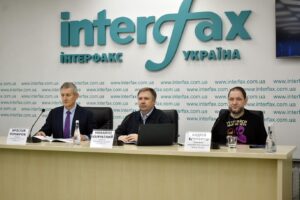
Ukraine’s economic security index in 2025 fell from 35.2 to 33.4 points out of a possible 100 due to the deterioration of social, regulatory, intangible, and institutional factors, according to the results of an annual study announced by the International Institute for Liberty at a press conference at the Interfax-Ukraine agency in Kyiv on Wednesday.
“Ukraine’s national economic security system is in a dangerous ‘orange’ zone, having deteriorated over the past year.
The main threat to economic security is the functionality, size, and discretion of the state,” the authors of the study conclude.
They specified that the ILI Index is calculated based on an analysis of 59 indicators grouped into eight categories and is applicable to any country with a transition economy.
As part of the study, the index was calculated for nine other countries: Finland, Germany, Israel, and the United States were in the “green” zone with scores ranging from 79.5 to 70.6 points; The Czech Republic, Poland, and Romania, with scores ranging from 69.8 to 54.4 points, were in the “yellow” zone, while Ukraine’s partners in the “orange” group were Turkey and Argentina, but their scores were higher, at 49.8 and 41.9 points, respectively.
The main deterioration this year occurred in the following factors: social – from 57.3 to 42 points; regulatory – from 43.5 to 35 points; intangible – from 54 to 48 points; and legal and institutional – from 53.5 to 48 points.
At the same time, the situation improved in three areas: infrastructure – from 22.1 to 33 points; monetary and financial – from 16.5 to 26 points; and macroeconomic – from 19.9 to 21 points, while tax and budgetary factors remained at the lowest level of 14 points.
“Ukraine is losing even regional competition for advanced technologies and profitable niches in global value chains. Without a change in the relationship between the state and business, the erosion of Ukraine’s comparative advantages after victory in the war will accelerate,” according to the International Institute for Freedom, whose founders include Volodymyr Poperechnyuk, co-owner of Nova Poshta, Serhiy Bashlakov, co-founder of the distribution company MTI, and Yevhen Lemberg, co-founder of the Arikol Group of Companies.
The authors of the study recommend that the government conduct a thorough review of legislation “taking into account scientific conclusions and empirical observations,” reduce the functions, size, format, and mode of the state’s presence in the economy, and abandon the practice of “growth points” and strategic sectors.
They call on the government to deregulate, privatize, implement new fiscal and monetary policies, and conduct an annual audit of the state with clear deadlines for improving economic policy parameters.
The International Liberty Institute positions itself as an independent, non-profit, non-partisan think tank whose activities are aimed at promoting, developing, and strengthening the ideas and values of freedom through expert analysis and practical solutions for the economy and politics. The president of the ILI is Yaroslav Romanchuk, and the director is Mykhailo Kamchatnyi.
Dynamics of changes in discount rate of NBU – from 2014 to 2025

Source: Open4Business.com.ua

Vegetable oils accounted for 23% of Ukrainian exports in 2024, 60.9% of which went to European countries, according to the Ukrainian Agribusiness Club (UAC).
Analysts noted that 15% of vegetable oil exports from Ukraine were delivered to the Middle East, 14.8% to Southeast Asia, 4.8% to Africa, 3.1% to Asia (other countries), and 1.4% to America.
At the same time, sunflower oil accounted for 89.0% of exports, soybean oil for 5.5%, rapeseed oil for 4.2%, and others for 1.3%.
The UACB noted that sunflower oil accounts for the lion’s share (89%) in this category, which confirms Ukraine’s status as a key player in the global market for this product, while the share of soybean and rapeseed oils is also gradually increasing.
After record revenues of $7.04 billion from oil exports in 2021, even in the context of full-scale war, export revenues consistently exceed $5.6 billion annually. The 2024 figure ($5.76 billion) confirmed that this sector has not only survived but also successfully adapted to the new realities, remaining a reliable pillar of the economy, the business association emphasized.
At the same time, unlike raw material groups, vegetable oils as a processed product have a more diversified geography. Although Europe remains the leader, the total share of Asian and Middle Eastern countries exceeds 30%, which indicates the demand for Ukrainian oil in distant markets. The global demand for Ukrainian oil is confirmed by the overall improvement in export logistics and the increase in the number of importing countries, which rose to 139 in 2024 (compared to 133 in 2023).
“Vegetable oils remain a significant driver of Ukraine’s foreign trade among value-added products. One of the critical factors for exports remains the issue of the availability of logistics routes,” the association emphasized.
The UACB recalled that in 2024, the deep-water ports of the Black Sea regained their dominant position, accounting for almost half of all exports (compared to less than 15% in 2023), but alternative export channels—the Danube ports and the “Solidarity Routes”—continue to play a significant role, accounting for over 45% of shipments.

The Verkhovna Rada’s Temporary Investigation Commission on Investor Rights Protection insists that customs and law enforcement agencies respond to the situation with Ukraine’s import of roses, 95% of which cross the border illegally, said the chair of the Temporary Investigation Commission, People’s Deputy (Servant of the People) Galina Yanchenko.
“Flower mafia”: 95% of imported roses in Ukraine are brought in illegally. As a parliamentary special commission, we demand a response to this problem from customs and law enforcement agencies,” she wrote on her Facebook page.
According to Yanchenko, on Wednesday, the Temporary Investigation Commission held a meeting on the protection of investors’ rights, dedicated to the situation with flower smuggling.
“Miracles” really do happen with roses entering Ukraine. Six months ago, after receiving complaints from businesses, we compared Ukrainian customs data with European databases and saw systematic abuses: massive underestimation of customs value, budget losses of more than UAH 600 million over three years, and the destruction of domestic producers through smuggling and dumping. In other words, we are not just dealing with customs schemes, but an attempt to kill Ukrainian floriculture,” the MP noted.
Yanchenko said that the materials collected by the Temporary Investigation Commission have already formed the basis of criminal proceedings by the Economic Security Bureau, with preliminary estimates of at least UAH 100 million in abuses.
“But this is not enough. We expect real investigations and the perpetrators to be brought to justice. If the situation does not change, we will join forces with law enforcement agencies to conduct joint raids and inspections of suspicious cargo at customs,” warned the chair of the Temporary Investigation Commission, reminding everyone that every hryvnia counts during wartime.
The Temporary Investigation Commission meeting was attended by representatives of the State Customs Service, the Economic Security Bureau, the State Bureau of Investigation, the Office of the Prosecutor General, as well as Ukrainian manufacturers and importers.
As reported, in 2021, Ukraine introduced a special duty on imports of cut fresh roses for three years, regardless of the country of origin and export. The duty rate in the first year of its operation was 56%, in the second – 44.8%, and in the third – 35.84%.
Based on the results of the duty’s impact provided by the Ministry of Economy, the Interdepartmental Commission on International Trade (ICIT) concluded that the application of special measures had a positive effect on the activities of domestic producers, but did not completely eliminate the consequences of the damage caused to them. Therefore, recommendations to extend the duty have been submitted to the ministry.

According to Serbian Economist, Serbia’s commercial real estate market will develop around Belgrade and expressway and railway corridors over the next decade, with the most dynamic growth expected in the office and industrial-logistics segments, according to the analytical report “Serbia real estate & construction outlook 2025–2035.”
According to the document, by 2035, Belgrade’s high-quality office stock could increase to 1–1.2 million square meters. The main demand will be provided by IT companies, engineering centers, the financial sector, and international service centers, while in Novi Sad and Niš, more compact clusters of office space focused on technology and research are forming.
The report identifies industrial and logistics real estate as the fastest-growing segment. Experts predict that by 2035, the total volume of modern warehouse space in Serbia could double or triple, with key logistics hubs forming in the Belgrade–Pancevo–Simanovci, Novi Sad–Ruma–Inđija, Kragujevac–Kraljevo, and Niš–Leskovac, as well as along international corridors X and XI.
Individual industry reviews confirm the stability of the industrial segment: according to consulting company iO Partners, in the first quarter of 2025, there were more than 1.2 million square meters of Class A warehouse space on the Serbian market, with vacancy rates remaining at around 6.5% and base rental rates at €5 per sq m per month, indicating a balanced supply and demand structure.
The report identifies potential delays in infrastructure projects, high financing costs, and political cycles that could affect the timing of major development programs as risks for commercial real estate. As strategic recommendations, investors are advised to focus on energy-efficient offices and industrial parks linked to international transport corridors, while the authorities are advised to accelerate the harmonisation of building standards with EU requirements and the digitisation of procedures for commercial projects.

Kyivstar, Ukraine’s largest mobile operator, will gradually update certain tariffs from December 18 this year and throughout early 2026 to compensate for the rising cost of key resources.
“Starting December 18, 2025, and throughout early 2026, the terms of some subscription rates will be gradually updated, and starting January 1, 2026, and over the course of several months, some contract and business rates will also be updated,” the company said.
It is noted that these conditions are being introduced due to the rise in the cost of key resources, in particular, electricity for businesses, which has risen by 60% during evening peak hours.
The technical community of the telecommunications market “Mobile Communications of Ukraine” reported on Telegram that the new tariffs will affect, among other things, the LOVE UA line. Specifically, LOVE UA Base will increase from 150 UAH to 200 UAH/4 weeks, LOVE UA Bezlim 2024 from 225 UAH to 300 UAH, LOVE UA Pesnya 2024 from 250 UAH to 300 UAH, LOVE UA Svet 2024 from 200 UAH to 260 UAH, LOVE UA Light 2024 (with the superpower Economy) will increase from 150 UAH to 200 UAH, and the LOVE UA Freedom 2024 tariff will increase from 125 UAH to 190 UAH.
Among other changes, the operator announced the expansion of the “Roaming as at home” service from 28 to 32 countries, including Iceland, Norway, Liechtenstein, and Cyprus, starting December 18.
For subscribers abroad, roaming limits of UAH 2,000 and UAH 4,000 will be introduced from January 1, which will help avoid unexpected Internet costs.
As reported, Kyivstar received EBITDA of UAH 7.1 billion in the third quarter of 2025, which is 21.5% more than in the third quarter of 2024, and in dollars, the growth was 20.4% to $171 million.
Kyivstar served 22.5 million mobile subscribers in the third quarter of 2025, which is 3.6% less than a year earlier, but the number of 4G customers grew by 2.4% to 15 million.